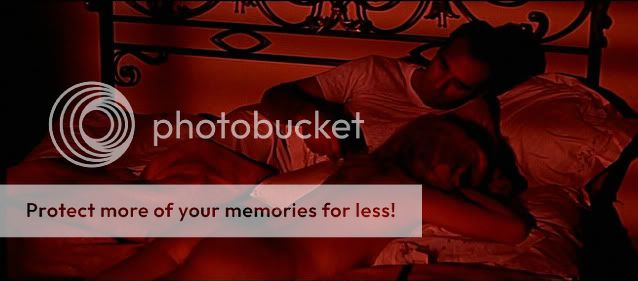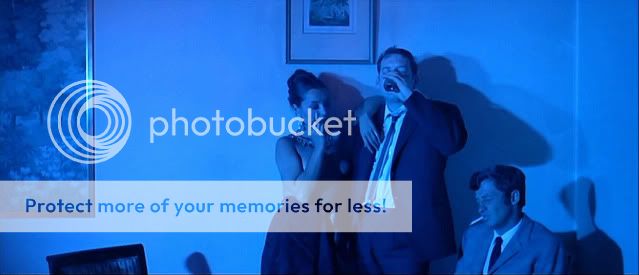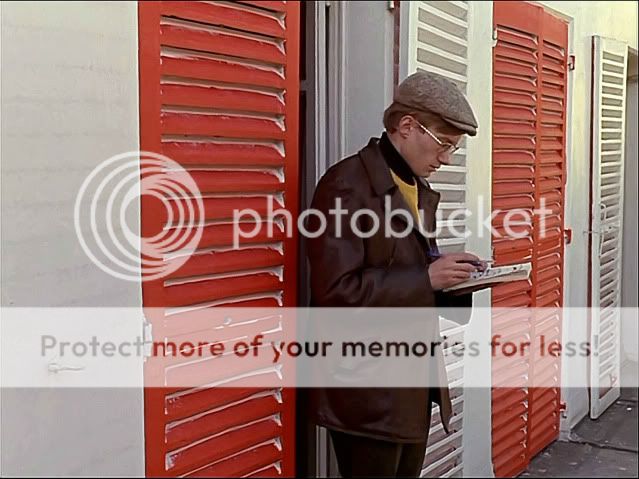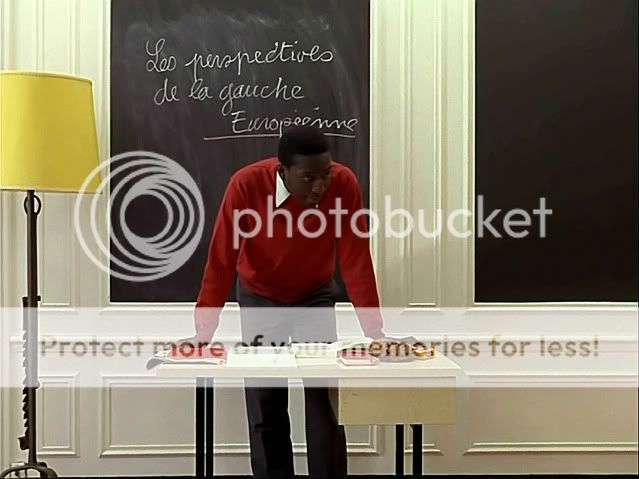
Over at Bill's pad, The Kind of Face You Hate, a post about the great Val Lewton segued into a discussion as to the merits of Godard's more 'minimalist' black and white films versus his more 'formal' color pictures. Since I've been inundated with finals and projects and the like, my time to waste with my fellow movie nerds (I mean that affectionately) has been cut down severely, and I missed out on a fascinating discussion with my pals Bill, Ed, and Greg about one of my personal favorites (it was already several posts ago at Bill's blog, damn you guys and your commitment to updating!). So consider this my own bumbling contribution to that particular thread. I'll look at five of Godard's first six seven color features, and try to explain why his use of color has so impacted the way I watch movies.
I don't know if a film maker has ever taught me more about screen color and its implications than Jean-Luc Godard. This is, after all, the film maker who understood that sex, communism, and blood all register the same to the eye--- on the screen, it's red. From his debut film Breathless, his agenda has been highly formalist (though certainly not strictly formalist), and his color films were a natural continuation of his rumination on the psychological and cultural powers of cinema. The above pictured moment from Contempt, his first film in Cinemascope, typifies in many ways the self-reflective way Godard treated the medium. He turns the camera on the audience, inviting us to see the illusory power of cinema through a looking glass.
Take a look at the scene from Contempt that introduces the married couple played by Michael Piccoli and Brigitte Bardot. The legend is that Godard was forced to shoot a nude scene with Bardot by the studio, because they wanted to return their investment on their investment in Bardot, who was seen as a sex symbol of the time (though that's truly something that's lost on me). His use of color speaks volume about their relationship from the moment the movie begins.

We would normally associate a dark shade of red with intimacy and passion, and Godard subversively uses this effect to highlight their emotional distance from each other. He gives us nudity without eroticism (and no, this whole post is not just an excuse to show Bardot's ass , thankyouverymuch).

And, in an instant, what little illusion of intimacy there was is shattered, with a return to 'natural' lighting. If it wasn't already, the type of relationship these two characters have is already very clearly spelled out.

Then, he switches to a blue hue to highlight the coldness of their relationship. Again, the color usage has an instant psychological association and its the colors that convey the ideas, both narrative and formal, of the scene.
Cinemascope wasn't meant for human beings. Just for snakes - and funerals. -Fritz Lang in Contempt
In the beginning of the film, Godard wants to give us an impression of how Ferdinand/Pierrot's nice, quiet home life is suffocating in order to align our sympathies with the little road trip that Ferdinand is about to take with Anna Karina. Notice the way the colors the little girl is wearing matches the colors of the bathroom. A little detail like that gives us the impression of how uniform his life is and how Ferdinand's existence is defined by routine.
When he goes to a party early in the film, Godard uses colors to seduce us into the nightlife--- we've escaped the tranquility of his home-life, and gone into the enticing world of drinks, celebrities, and sex. Again, the color contrast is what defines this narrative thread. Godard wants us to sympathize with the with Ferdinand's gravitation towards a new life of lust, danger, and adventure.
When he goes to a party early in the film, Godard uses colors to seduce us into the nightlife--- we've escaped the tranquility of his home-life, and gone into the enticing world of drinks, celebrities, and sex. Again, the color contrast is what defines this narrative thread. Godard wants us to sympathize with the with Ferdinand's gravitation towards a new life of lust, danger, and adventure.

Later on in the film, as Karina is attempting to entice Ferdinand to join him, the use of light and color is essential to fleshing out the psychological state of the two main characters. As they drive discussing their plans, flashing , blurred light blinds these characters to reason. It's an incredibly romantic, visually extravagant scene--- among my favorite moments in Godard's filmography (that I've seen).


At the end of the film, Ferdinand has reached the end of this rope and has gone somewhat insane (skip the next image and paragraph if you don't want Pierrot le Fou spoiled for you).

He's a little upset, as you can see... you might even say he's feeling blue! (bwahahaha) Godard literalizes the concept of 'being blue' visually, having his character paint his face blue to externalize his internal feelings of suffering. It's a stroke that is simultaneously ironic, tragic, and hilarious.
The next feature I'll be looking at, Made in U.S.A., is an effective bridge between the more playful, genre driven style of Pierrot le Fou and the more politically driven films I'll be taking a look at a little later on--- La Chinoise and Weekend (which is not to imply in any way that Pierrot le Fou is apolitical--- just less politically charged than the next three).

An early sequence has the main couple discussing the woman's sexual experience in a manage-a-trois. Godard holds the camera statically and keeps them in silhouette for what feels like an agonizingly long period of time, and the lack of clearly-defined colors here is as important as the abundance of it in his previous features. Keeping them in the shadows allows us to focus on the grotesqueness of what is being described, and this is in keeping with the film's modus operandi, making us uncomfortable in our own skin.

This is certainly when Godard became more of a blatnat polemicist, and I think the lack of an extravagant color-palette is part of what is touted as his stylistic 'return to zero'. Also, Godard is capturing the French country side in this movie, and I think he wants human beings to be just another part of that expansive landscape--- perhaps even an unnatural part. So the use of color is still there and still vital, it's just used to express a different sect of narrative ideas.




So, to me, his use of color is a large part of Godard's appeal--- he was one of the first film makers to show me what the power of carefully thought out and arranged color elements within a frame--- the ideas they can express on the narrative, formal, and even political level. It's the painterly aspect of cinema that so few artists have embraced quite as blatantly as Godard did. I don't know if his black and white films would qualify as more minimalist in tone--- La Chinoise and Weekend are stylistically less flamboyant than a film like Breathless, which announces from its opening frame that it's going to play with genre and form in a very blatant way. La Chinoise and Weekend are actually more minimalist in tone than some of his earlier black and white pictures--- establishing simple visual motifs and then mixing them up to further the motions of character and plot along. But the intrinsic appeal of Godard to me is that visual sensibility--- the way he uses colors and their psychological association to express his core narrative.

The next feature I'll be looking at, Made in U.S.A., is an effective bridge between the more playful, genre driven style of Pierrot le Fou and the more politically driven films I'll be taking a look at a little later on--- La Chinoise and Weekend (which is not to imply in any way that Pierrot le Fou is apolitical--- just less politically charged than the next three).

"It's like being in a Disney film with Humphrey Bogart", Anna Karina's character Paula Nelson says amidst the mad-cap absurdity of Made in U.SA., and that more or less encapsulates the formal and genre rumination Godard was attempting with this film. He tests our dependence on genre familiarity by giving us the most bizarre kind of mash-up imaginable; combining the eye poppingly-colorful and extravagant world of a Disney picture with the inward melancholy of film noir.
I tend to use the word 'test' in relation to Godard at all, and I don't mean to give the impression that he's strictly academic. His love of genre is always apparent, but the genre conventions are often a mask for queries into the nature of art. He breaks cinema down to its essentials--- to image and sound. There's a key sequence in Made in U.S.A. when he removes the soundtrack completely and we're just left with images--- which is actually very reminiscent of the "Meet the Soundtrack" segment of Fantasia--- where the artifice aspect is flaunted and used to investigate the physiological way images and sound affect us.
And Made in U.S.A. is just a colorful blast of a film, an absolute feast for the eyes. Hell, Karina's dress is more colorful than most other entire movies. Again, Godard's use of color here is painterly and eye-popping.



Of all the features I've discussed, color probably plays the most important role in the politically charged La Chinoise, a film that simultaneously documents and critiques leftist politics. La Chinoise stands as a fascinating time-capsule of the atmosphere that led to the 1698 student revolts, though the movie is in no way a call to arms. Rather, because Godard strikes me as the sort of person who doesn't want to agree with anyone about anything ever, he is critical of the drone-like way youth-culture is indoctrinated to the ideas of communism (or any philosophy) , how they simply go along with the parlance of their times rather than truthfully analyzing the philosophy itself--- they regurgitate the ideas they read in their endless stacks of red books, but they don't necessarily take the ideals to heart, much less think seriously about them. Are they even aware of what they're endorsing?
Naturally red plays an important factor in the movie, and Godard toys with the way we associate red with communism throughout the picture (there's hardly a frame that doesn't contain some element of red), and this is perhaps when his use of color most clearly plays a role in the narrative syntax because they are a large part of what convey the film's political ideas. "We should replace vague words with clear images", text at the beginning of the film says, and Godard's use of color is what illuminates the ultimate socio-political meaning of the images. His images are truly worth a thousand words.




Moving on to the final feature I'm going to discuss today, Weekend, Godard's bright, high contrast use of colors that I've been discussing here is replaced with a more saturated color tonality--- perhaps Godard turning away from what he called film's bourgeoisie history. But this doesn't mean that Godard's color minimalism with Weekend is any less vital to the general tone of the film than his previous, more colorful films.
I tend to use the word 'test' in relation to Godard at all, and I don't mean to give the impression that he's strictly academic. His love of genre is always apparent, but the genre conventions are often a mask for queries into the nature of art. He breaks cinema down to its essentials--- to image and sound. There's a key sequence in Made in U.S.A. when he removes the soundtrack completely and we're just left with images--- which is actually very reminiscent of the "Meet the Soundtrack" segment of Fantasia--- where the artifice aspect is flaunted and used to investigate the physiological way images and sound affect us.
And Made in U.S.A. is just a colorful blast of a film, an absolute feast for the eyes. Hell, Karina's dress is more colorful than most other entire movies. Again, Godard's use of color here is painterly and eye-popping.



Of all the features I've discussed, color probably plays the most important role in the politically charged La Chinoise, a film that simultaneously documents and critiques leftist politics. La Chinoise stands as a fascinating time-capsule of the atmosphere that led to the 1698 student revolts, though the movie is in no way a call to arms. Rather, because Godard strikes me as the sort of person who doesn't want to agree with anyone about anything ever, he is critical of the drone-like way youth-culture is indoctrinated to the ideas of communism (or any philosophy) , how they simply go along with the parlance of their times rather than truthfully analyzing the philosophy itself--- they regurgitate the ideas they read in their endless stacks of red books, but they don't necessarily take the ideals to heart, much less think seriously about them. Are they even aware of what they're endorsing?
Naturally red plays an important factor in the movie, and Godard toys with the way we associate red with communism throughout the picture (there's hardly a frame that doesn't contain some element of red), and this is perhaps when his use of color most clearly plays a role in the narrative syntax because they are a large part of what convey the film's political ideas. "We should replace vague words with clear images", text at the beginning of the film says, and Godard's use of color is what illuminates the ultimate socio-political meaning of the images. His images are truly worth a thousand words.




Moving on to the final feature I'm going to discuss today, Weekend, Godard's bright, high contrast use of colors that I've been discussing here is replaced with a more saturated color tonality--- perhaps Godard turning away from what he called film's bourgeoisie history. But this doesn't mean that Godard's color minimalism with Weekend is any less vital to the general tone of the film than his previous, more colorful films.

This is certainly when Godard became more of a blatnat polemicist, and I think the lack of an extravagant color-palette is part of what is touted as his stylistic 'return to zero'. Also, Godard is capturing the French country side in this movie, and I think he wants human beings to be just another part of that expansive landscape--- perhaps even an unnatural part. So the use of color is still there and still vital, it's just used to express a different sect of narrative ideas.




So, to me, his use of color is a large part of Godard's appeal--- he was one of the first film makers to show me what the power of carefully thought out and arranged color elements within a frame--- the ideas they can express on the narrative, formal, and even political level. It's the painterly aspect of cinema that so few artists have embraced quite as blatantly as Godard did. I don't know if his black and white films would qualify as more minimalist in tone--- La Chinoise and Weekend are stylistically less flamboyant than a film like Breathless, which announces from its opening frame that it's going to play with genre and form in a very blatant way. La Chinoise and Weekend are actually more minimalist in tone than some of his earlier black and white pictures--- establishing simple visual motifs and then mixing them up to further the motions of character and plot along. But the intrinsic appeal of Godard to me is that visual sensibility--- the way he uses colors and their psychological association to express his core narrative.






26 comments:
Just discovered the blog, so compliments on the great writing you do here. I'm pretty much a novice in regards to Godard and have seen only two of the films that you mention (Contempt and Pierrot le fou), but the analysis of the use of color in Contempt is very interesting. Contempt was a film that I struggled with, at least with the narrative, but it looked great the whole way through.
The little girl in my opinion does not represent the constraining aspects of Belmondo's life but rather serves as an extension of himself being constrained. Notice how as she enters Belmondo is talking about crushed childhoods that she represents. Her toting of the primary color blue is meant to align ourselves with her and identify her as not being the culprit. She too is a person being constrained although she does not yet realize it. Notice how she is dragged away by her bourgeois mother into that most ungodardian of bedrooms. The bathroom represents the last pathetic refuge Belmondo has in this most banal of worlds he lives in. Notice that the only blue in the room is the towel lieing in the corner of the room that the daughter steps directly in front of? I feel that the blue in this portion of the scene, does not serve as a constraining element but a small reminder of those Godardian primary colors that are being bogged down. The colors in the bathroom being limited serving just to take our focus off of the visual and focus on the auditory elements to draw further attention to the gaffes between the quotations and readings Belmondo is often delivering to us with the sometimes contradictory images we are being delivered.
regarding the infamous party scene, those monochromatic colors are anything but enticing. Samuel Fuller's cameo might throw you but it does come at the end of the scene immediately preceding Belmondo's asking for the keys and throwing cake all over everyone. The dull tones that drown out the life of the characters in frame and just serve to further underline the awful conversation and interactions these people are having with one another are not at all indicative to what Belmondo is looking for. and finally I do not believe Ferdinand is seeking a life of lust but rather a realization of the lust for life he has been displaying. He just never struck me as being obsessed with the celebrity booze and lusty elements that seem to be more indicative of what he was running from. Samuel Fuller's cameo seems to be more about his being an artist than a celebrity.
Godard's colors are great, good post, good blog, good luck and god speed.
A great post, though you skipped Godard's actual first color feature, the light-hearted musical deconstruction A Woman is a Woman.
Anyway, I especially love what you have to say about La Chinoise, which is too often dismissed as polemical and Maoist and what-have-you. But Godard is way too shifty to be pinned down like that for long; the film is as critical of the "radical" students and their vague ideas as it is of the bourgeois establishment. I love how fun and playful that film is.
You also do a great job of discussing the way color runs through these films. One of the central paradoxes of Godard's 60s color work is his use of bold primary colors to express subtle, nuanced ideas. His color palette is bright and often stripped-down to a few prominent choices (blue and red especially) but the effects he gets from the combinations of these colors are much more complicated than one would expect.
@ Dave: Thanks for reading. I was actually watching Contempt later on in the day I posted it and I absolutely see where you're coming from, it is a very difficult, deliberately polarizing film. I wonder if the marriage of these two quite contemptible people is worth elevating to the tragic-Greek heights that he does. Still, the film is a real stunning piece of work from beginning to end.
@ Kingsley Zissou: That's a hell of a contribution! Thank you very much. Though I'm not sure I understand the distinction between the girl 'representing the constraining aspect of Belmondo's life' but instead represents 'an extension of himself being constrained'. But your analysis of the bathroom scene is wonderful and goes deeper than my own comparatively paltry analysis.
And you may have also shed some light on the party scene--- but perhaps Fuller was representing the line between celebrity/art? You may be right that Godard is using the colors to give us a false sense of excitement, but doesn't this just really serve as a lead-in to Ferdinand running away with Karina's character, anyway? Your added thoughts would be appreciated.
@ Ed: D'oh! I wanted to check to make sure their weren't any before Contempt, as I did have a feeling that A Woman is a Woman might be in color. I think I got it confused with Une Femme Mariee. Thanks for catching my slip up, my friend.
One of the great misconceptions of La Chinoise at the time of its release was that it was a film that was endorsing leftist politics, which is funny because watching it today what sticks out most is its non-committal to these days and the way it puts those ideas under a microscope. Have you seen Bertolucci's The Dreamers? It's similarly critical of youth leftist politics, but it's something of a more romantic tribute to the time than Godard's film.
I haven't seen The Dreamers yet, though I do want to. What's striking about Godard is just how brief his true commitment to student politics was: it lasted basically as long as the Dziga Vertov Group, and those little-seen films are essentially the only ones in his career where he commited himself more or less wholly to one viewpoint. In all his other politically radical films before that, he was constantly questioning even his own political ideas, including dialectical opposites even for his own ideas. Even in the DVG films, he's not above the questioning of different methodologies and self-critique of his own films. Godard is a much more complex figure than a lot of people give him credit for.
That's very true, Ed. He doubts even his own convictions--- maybe even especially his own convictions. I like his writing but it borders on being utterly incoherent--- his pieces are really just strings of ideas--- but man, what great ideas they are! As he started making films he became much less forceful with his views, which is an interesting shift in its own right.
I will view all of these again and be the final judge.
The Final Judge!
And then you will know if it is acceptable to like them or not.
I watched Weekend and Contempt in the past year or so (and used both in my short montage Frames of Reference with Contempt having a starring role) and I still enjoy them but I'm simply not as enamored of them as you and Ed. I'm not totally on the other side either like Larry Aydlette who says Contempt is simply a reason for Godard to show Bardot's ass again and again (like your post - just kidding), but I think they are good solid movies that many people perhaps read too much into.
I don't know, I get the feeling Godard was more fun and playful, as Ed says, than many are willing to admit. In other words, I think he didn't have many grand schemes in mind but knew cinephiles would devise layers and layers of meaning if he just played with genre and visual expectations a bit. In other words, a bit like Dali or Hirst in that he enjoys purposely putting out something without meaning knowing his loyal followers will ascribe all sorts of meaning to it. And actually, that makes him more interesting to me so I'm not trying to insult him with that. It's actually praise on my part. I like the idea of it though very much.
And did I read you correctly? This is lost on you as a sex symbol? Do you have a pulse? Does Margaret Hamilton get you hot and heavy? I mean, truly, madly and deeply - What the hell?
I'll try and dig up some pictures of Ruth Buzzi for you to swoon over. I'll let you know what I find.
I don't know, I get the feeling Godard was more fun and playful, as Ed says, than many are willing to admit. In other words, I think he didn't have many grand schemes in mind but knew cinephiles would devise layers and layers of meaning if he just played with genre and visual expectations a bit. In other words... he enjoys purposely putting out something without meaning knowing his loyal followers will ascribe all sorts of meaning to it....
Well now, I think Godard is playful and fun, but I certainly don't think his films are without conscious meaning. It's fairly obvious to me that he thinks very carefully about the meanings of his films, something which becomes impossible to ignore post-1968, when the films become very self-reflexive and Godard's internal dialogue about filmmaking is increasingly written right into the films. There are few filmmakers who think more deeply and intensely about their craft than Godard does.
Oh and Ryan, yeah, I meant to comment on the Bardot thing. The blonde bombshell type isn't my usual preference, but there's no denying the appeal of Bardot. Especially in Contempt. Yeesh.
I don't doubt he thinks about the meaning, just that more layers are ascribed to it than he intends. And since you said it is "impossible to ignore post-1968" that's where I would remind you that I am mostly familiar with his pre-1968 output so viewing the later stuff again may supply me with an entirely different outlook.
And besides, thinking out a shot thoroughly doesn't mean you are giving it meaning. You could simply have a strong visual sense of what you want to show without knowing what it means. I believe the lesser, more mediocre products of art are precisely those in which the artist is thinking about meaning. The grand works come from the soul of the artist and have rich, profound meaning for many but mainly because it sprang from the artist's feelings and not from their pre-meditated blueprints and outlines of meaning.
To make it easier to understand -
Stanley Kramer: Films made with pre-meditated Meaning.
Robert Altman: Films made with soul and open to meaning given them by the viewer.
So you see, by my definition, Godard is a more soulful filmmaker. By your definition of him thinking intently about the meaning of each shot, he's more a Stanley Kramer hack. Now Ed, I thought you liked Godard?
Just to state the obvious: you can think about meaning and not be Stanley Kramer. That said, yes, Godard does a lot intuitively and improvisationally. I'm not suggesting he works from a blueprint at all; far from it, he often starts a film with little preparation. I was just objecting to the idea that Godard is just messing around with the knowledge that the audience will fill in the meaning later.
I was just objecting to the idea that Godard is just messing around with the knowledge that the audience will fill in the meaning later.
I know, I admit I enjoy goading you and Ryan just a bit when it comes to Godard. I was going to take it further and start wondering aloud why you hated Godard so much and were so willing to run him down and sell him short but I thought better of it.
And of course, you defend your views excellently and have reinvigorated my interest in seeing his later works. And then I can come back and compare him to Robert Zemeckis or something and send you through the roof.
Well played, Greg, you can always count on me to take the Godard bait. Heh.
I'm looking forward to the essay about how Forrest Gump reflects Godardian filmmaking ideas.
Hello my friends, thanks for a fascinating chat while I was away (i.e., sleeping and/or in class).
Greg, as I said in my above comment I've definitely softened on Contempt. Watching it again I was wondering what was so special about Piccoli and Bardot's marriage in that film that was worth elevating to the heights of Greek tragedy (or trying to, anyway). Still, the film is gorgeous from first frame to last, but I wonder if it isn't a little on the hollow side.
Weekend is one of the most scathing indictments I've ever seen of any society--- but to me what appeals to me about that film is that it is a real 'trip', in the literal and figurative sense.
There are two Godard films I always go back to when I think of my favorites--- Masculine Feminine and La Chinoise. Both analyze the folly of youth culture, one with more of an emphasis on sexual drive and the other more political, but they have quite a few similarities as well, but I think I prefer Masculine Feminine because of that more playful disposition that the two of you have been discussing. But even Godard's more playful films have a kind-of subversive dark take on humanity.
And as for the Altman comparison, I'm not sure I understand why but I don't think Altman put conscious meaning into his films, either (I can't even tell you how many people have called Altman a 'rambling pot-head' or the like). Take Short Cuts (the film from which this blog derived its banner and namesake), do you think Altman was consciously thinking about every little connection and about how this microcosmic look at a handful of characters can simultaneously be an all-encompassing look at the human race, almost a mirror looking back at humanity? Or does this part only come after? What I'm asking is how many artists do consciously say "Okay, this means this and that means that" with respect to their work? I've never felt that way with Godard, honestly, I've always felt that his films were communicating the pictures and ideas in his head.
It reminds me of a moment from Imagine, the John Lennon documentary. At one point there is some drifter who stands in front of John Lennon's house for something like a few days, so Lennon goes over to talk to him to see... what the hell this dude wants (you see why he got shot, this is the way the guy was). The guy starts explaining to Lennon about how much his music and the music of The Beatles meant to him. How "The Benefit of Mr. Kite" and other songs correspond to events and people in his life. Lennon responds to him "These songs are about nothing. I put the words together because they sounded good together. It's that simple." Art takes on an added meaning after the artist is done with it.
As for Bardot... sorry, Greg, make all the limp-dick jokes you want, she just doesn't do it for me. Forgive my language, but I feel like the only reason she was seen as a sex symbol here in America at the time is because she epitomized to young men the concept of the "French Slut". Her hair looks fake, and face-wise she looks like she fell out of the ugly tree and hit every branch on the way down. She has a nice body, but that's about it. Now, as for Ms. Karina... I would have her for breakfast, lunch, and dinner! Again, personal taste and there really is no accounting for it.
And Forrest Gump is very Godardian. We all know that, if Godard could have afforded it, he would have totally ended one of his movies with a FUCKING CGI FEATHER FLYING INTO THE SCREEN. He just never had the resources.
sorry, Greg, make all the limp-dick jokes you want.
Okie dokie! Ha ha, Ryan has a limp dick! Hey everybody look, he can't get it up! Ha ha ha!
Okay I'm done. So anyway, what John Lennon says in that is so true. And that's a great moment by the way, when the drifter thinks/feels that Carry that Weight was written for him and John says, "Well it was written by Paul and it was about the four of us but it can be about you or anybody if you want it to." It's true.
Interviews and/or diary entries by everyone from Robert Frost and Virginia Woolf to John Lennon and Werner Herzog (there's a great transcript of an Ebert/Herzog interview from the early eighties I highly recommend reading) have confirmed time and again that the best artists produce works from feelings, thoughts and emotions without thinking about symbolism or overt meaning. They all talked about how that came in later from the reader, listener or viewer.
Like Ed said, it doesn't mean there is no design. It's not formless and of course they've put thought into it, but it means that Fitzgerald isn't thinking, "Okay, now I want Gatsby to represent the shattered American dream of the average lower class citizen and as such I want his actions to directly symbolize... etc. etc" When you start doing that your name is Clifford Odets or Stanley Kramer and your work is pedestrian as a result.
I hate that tendency to attribute anything slightly weird or outside of the mainstream to the influence of drugs, like calling Altman a pothead. After seeing King Lear on Friday, as I was walking out there were these two guys talking about how weird the movie was and one guy said something like, "oh it was the 80s, who knows what kind of pipe they were passing around." I kinda wanted to grab him and shake him.
It's a shame, though, that Godard has never been able to afford the CGI he so badly wants to use. He had to seriously downsize the big action finale to First Name: Carmen and scrap the planned special effect miracles from Hail Mary.
Ed, you just said a mouthful! Peter Yarrow gets incensed when he hears people say that PUFF THE MAGIC DRAGON is about drugs. He and Leonard Lipton who wrote the original lyrics had nothing like that in mind for it at all.
One thing I bring up to people is John Lennon's continuing denial of a drug influence on or about LUCY IN THE SKY WITH DIAMONDS. He said until his very last interviews it had NOTHING to do with drugs! It was based on the style of his favorite writer, Lewis Carroll. I ask people who buy into the drug influence malarkey why a rock star who never shyed away from using drugs and would have looked incredibly cool to so many hippies in 1967 by "confessing" it WAS about drugs would DENY that it was about drugs? The only reason someone like Lennon in his position in pop culture would deny it is if in fact IT HAD NOTHING TO DO WITH DRUGS!!!
God people are stupid!
I too have always despised the notion that anything out of the 'ordinary' (as though ordinary exists) is written off as because od drug use. I don't know how you managed to resist the temptation to hurt those two individuals at the BAM screening. You're a better man than I am, Gunga Din.
And yes Greg the "Lucy in the Sky With Diamonds" LSD thing is a little ridiculous. Not to mention, Lennon derived the title from a painting his son painted in elementary school. It can't simultaneously be a drug reference AND from his son's painting, unless of course that person is suggesting that Julian was tripping, too!
Yes, people can be dumb--- it's part of their desire for everything to come wrapped up in a neat little package, and anything that doesn't conform to that is written off as a bad 'other', in this case the result of drug use. It also plays into the way drugs are demonized to absurd proportions.
"the colors the little girl is wearing matches the colors of the bathroom. A little detail like that gives us the impression of how uniform his life is and how Ferdinand's existence is defined by routine."
Hello, Ryan
All that I was trying to say is that Godard wasn't trying give us the feeling of uniformity with the blue in the bathroom. It is just that I feel that the film's earliest scenes are meant to show how the life he aspires for does not quite match up with the life he lives and the juxtaposition between the spoken language and the image does not always match. E.G. Belmondo is talking about Velasquez drifting around objects like sunsets or something like that, but the image on screen is of two (presumably) bourgeois girls playing a bourgeois game, tennis. It is not until afterwards that we are shown the sunset. The same applies to the bathroom scene. The room may not be the most colorful in Godard but it does have the sole primary color. The real point of contrast to be drawn I felt was of Belmondo and the girl then being called into the bedroom where he is assaulted with magazine adds and blandest colors, while is reading material is called out for being inappropriate. The blue in the bathroom scene I feel is shown primarily to draw attention to the reds and blues in the next shot that are either half covered up or drowned out by colors such as pink and that lime green or whatever else is in that shot.
Maybe it was wrong to make that last post so much about the girl, I meant the towel and her clothing.
We all but agree on it,Hard Face.
Ryan -
Really nice post - very thoughful, very informative.
Lately, I've come to realize that m entire experience of Godard to date is watching "Vivre Sa Vie" in a college film class - and sleeping through half of it.
Now that I've gotten myself up to speed on Antonioni, I think Godard is the next director whose work I need to tackle. Your post is a helpful guidline for me to get started.
Hey, Pat, thanks for stopping in to my neck of the woods!
Vivre sa Vie is a favorite of mine--- simple, devestating, and true. I'd say you might want to go relatively-chronologically with Godard, if you can. It's interesting to see the way he develops his interests as he progresses.
And I feel guilty for still not watching Dancer in the Dark. I've been busy this week though and haven't really watched anything. When I watch it you will be the first to know. But I feel awful everytime I see it on my coffee table.
Re: "Dancer in the Dark" and feeling bad when you see it on your coffee table: Don't feel too bad, Ryan. Some of the participants felt just as awful when they saw it on their television screens!
Seriously, though, I understand all about the times when life competes with movies and blogging, so no worries. I will be interested to hear what you have to say when you have the time to watch.
Well now I have to! Plus, with the shit-storm his latest will undoubtedly stir up, now is as good a time as any to see more von Trier. I've seen Breaking the Waves and enjoyed it quite a bit.
Thanks for the love, although I just finished including the main chunk of my REAL post, which you can check out now.
Hey Ryan, sorry I'm late to this old post.
I recently watched La Chinoise... I guess I admired it, but I also found it to be something of a chore to sit through. The entire film (until the end, at least) seemed as though it just consisted of characters reading from books out loud- a typical Godardian touch, of course, but in this movie he really pushes it as far as it can go. And despite Godard's criticisms of a few of the elements of Maoism, there is no doubt that as a whole he sympathizes with it. Anne Wiazemsky talks on the DVD about how Godard's views were sometimes so extreme that he would preach his belief that Charles de Gaulle should be assassinated. I can't pretend that that doesn't bother me.
You know how Eva Yojimbo (our IMDB friend) once said that there's something in Godard's filmography for everybody to like? So far, the only film of his that I can claim to like a heck of a lot is Band of Outsiders. And that's probably saying a lot, considering that a lot of people think that's one of his most overrated.
That fact that I don't think very highly of Contempt also probably says a lot about my tastes. I essentially agree with Ebert on that movie; it's proof that Godard wasn't cut out for mainstream cinema. Meanwhile, Alphaville and Pierrot le fou are interesting entertainments, but it's hard for me to think of them as anything more (especially since I don't remember a single scene from Alphaville).
I'm still missing some important titles, though. I haven't seen either Breathless or Weekend, which is driving me nuts- considering that those two films are often touted as his best. But I can't find a copy of either film anywhere.
All in all, Godard doesn't come as naturally to me as Truffaut does. It may be that his constant rejection of narrative in each and every one of his films is difficult for me to dijest!
When we go through the concept of the expression enjoy, with comparison to its a close romance using one other, but for a emotion that's engendered once you have miltchmonkey a better romance on your own much too * or simply being a a sense greater unity with your family as well as humankind ( blank ) it then results in being much more extra ordinary that all everyone is looking to get in your life is actually appreciate.
شركة أعمال جبس بورد بالرياض
شركة تشطيبات داخلية بالرياض-شركة تشطيبات خارجيه بالرياض- شركة تشطيبات بالرياض شركة تشطيب فلل بالرياض -
منتديات اتصل بنا سوف يرد عليكم مهندس ومصمم ديكور بالرياض من أفضل شركة محل ديكور بالرياض متخصص لديه اقتراحات وتخيل لحل مشاكل الديكورات الداخلي للغرف والحمامات وديكورات الفلل لديه خبره في اختيار انسب وافضل الخامات لعرضها عليكم من شركة ديكورات بالريعن الديكور بسلطنة عمانتعد سحر اللمسات افضل شركة ديكور بالرياض
شركة ديكور بالرياض
اسقف معلقة - جبسنبورد – ارضيات
تصميم داخلي لديكور الفلل والقصور والمعارض والمشاغل والمحلات شقق ومنازل وديكورات مكاتب بالرياض وجميع انحاء المملكه
واحدة من الشركات الرائدة في مجال تصميبم الديكــــــــــــور الداخلي في مدينة الرياض, شركة ديكور بالرياض متخصصة في تقديم أضخم خطط المشاريع وخدمات شركة دهان بالرياض تكون افضل شركةالتصميم الداخلي للفلل والديكورات
التصميم الخارجي للفلل بالرياضشركة تنسيق حدائق بالرياض ومن أفضل شركات
انتقي من مجموعتنا الواسعة للتصاميم الخارجية ما يناسبك كالتصاميم المستوحاة من فن العمارةوجميع انواع الديكورات
الإسلامية, أو المتميزة
تصميم مطاعم بالرياض
شركة باركيه بالرياض لانها تتمثل
شركة تشطيب فلل بالرياض من أفضل
بطابع شرق أوسطي و غير ذلك
التصميم الداخلي للمكاتب بالرياض
دعنا نقدم لك تصميمآ داخليآ مبتكرآ لمكتبك الخاص بمساعدة مصممينا من الكيدرا, شركاؤك لتنفيذ أعمالك على أكمل وجه
Post a Comment